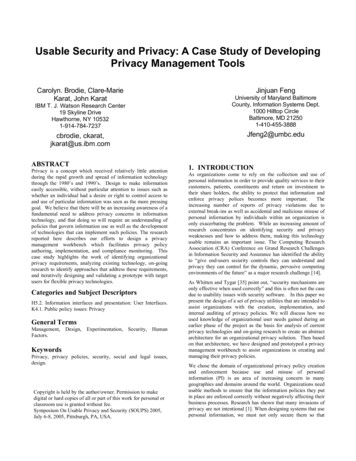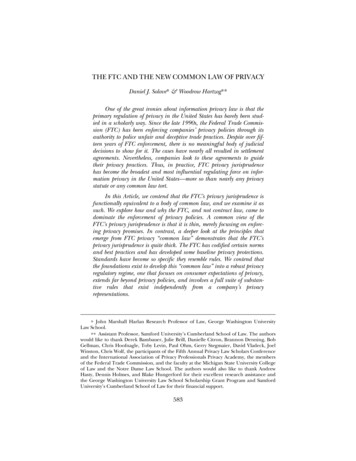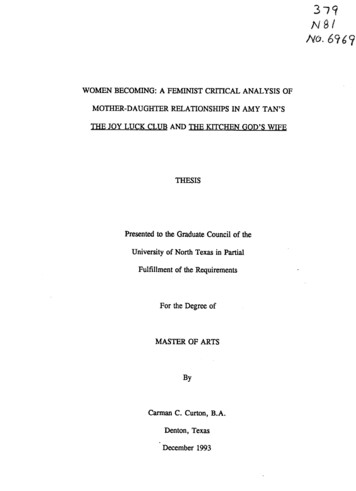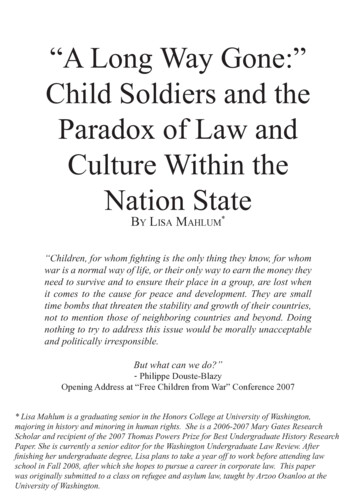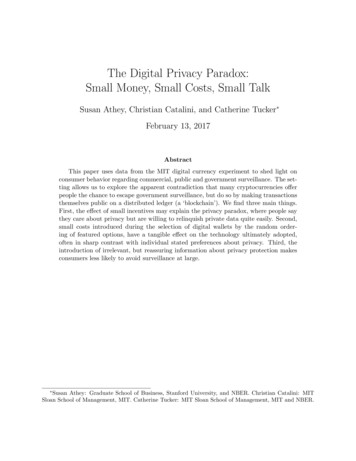
Transcription
The Digital Privacy Paradox:Small Money, Small Costs, Small TalkSusan Athey, Christian Catalini, and Catherine Tucker February 13, 2017AbstractThis paper uses data from the MIT digital currency experiment to shed light onconsumer behavior regarding commercial, public and government surveillance. The setting allows us to explore the apparent contradiction that many cryptocurrencies offerpeople the chance to escape government surveillance, but do so by making transactionsthemselves public on a distributed ledger (a ‘blockchain’). We find three main things.First, the effect of small incentives may explain the privacy paradox, where people saythey care about privacy but are willing to relinquish private data quite easily. Second,small costs introduced during the selection of digital wallets by the random ordering of featured options, have a tangible effect on the technology ultimately adopted,often in sharp contrast with individual stated preferences about privacy. Third, theintroduction of irrelevant, but reassuring information about privacy protection makesconsumers less likely to avoid surveillance at large. Susan Athey: Graduate School of Business, Stanford University, and NBER. Christian Catalini: MITSloan School of Management, MIT. Catherine Tucker: MIT Sloan School of Management, MIT and NBER.
1IntroductionIn the Fall of 2014, every undergraduate student at the Massachusetts Institute of Technologywas offered 100 worth of Bitcoin (Catalini and Tucker, 2016). Bitcoin is the first decentralized cryptocurrency to solve the double-spending problem that had plagued computerscientists’ early attempts at creating digital cash (Nakamoto, 2008; Narayanan et al., 2016).As part of the experiment, students would have to select a digital wallet offering varyingdegrees of privacy and security, decide how much information to share about themselves,and learn about encryption in the form of PGP to securely communicate their address andreceive their bitcoin. At multiple points in the process they not only faced trade-offs betweenprivacy, security and convenience, but also had to make choices in terms of who could accesstheir transaction data in the future.As an increasing share of economic and social activity is digitized, and as personal devices, services and governments collect more information about individual preferences andbehavior, it has become apparent that effectively protecting our privacy in a digital environment is extremely challenging. While having a chilling effect on online search behavior(Marthews and Tucker, 2015), revelations about the reach of government surveillance havealso accelerated the adoption of stronger, end-to-end encryption technology by some of theleading messaging platforms. At the same time, many established firms have responded toconsumers’ demand for more privacy through vague reassurances, often because their business models increasingly rely on the ability to collect and process vast amounts of data.1 Afew startups and open-source communities have instead developed solutions that either donot rely on information collection as a source of revenue, or that remove the intermediary’saccess to the data altogether, returning control over it to the users.This approach is similar to the motivation behind Bitcoin, which allows users to transact1For example, training machine learning models, understanding and predicting consumer preferences andbehavior, or offering personalization and customization.1
with each other without the need for a trusted third party. To verify transaction attributes ata low cost without relying on financial intermediaries (Catalini and Gans, 2016), the Bitcoinnetwork records all exchanges in a distributed, public ledger (a ‘blockchain’). While userscan protect their privacy by using different pseudonyms for each transaction, or by mixingtheir transactions with others, the public nature of the Bitcoin ledger makes it impossible toachieve full privacy from the public (Athey et al., 2016). Ironically, as Bitcoin offers peoplethe chance to escape government and corporate surveillance over financial transactions, itcurrently2 does so in a way that exposes part of that information to the public. Thisparadox extends beyond cryptocurrencies: as our lives become increasingly digitized andprivacy becomes costly or impractical to implement, often the relevant question becomesfrom whom one would like to maximize privacy.In this paper, we explore consumer choices with respect to privacy from three possibleaudiences: The government, an intermediary, and the public. Bitcoin offers a unique opportunity to study how individuals think about these privacy trade-offs because users havemultiple options for adopting the technology and for protecting their transactions. For example, when choosing a digital wallet to manage their bitcoin, they can download and runan open source wallet, or opt for a bank-like wallet service in the cloud provided by a commercial intermediary. Similarly, when transacting, they can take additional steps to protecttheir identity or not and the identities of their friends. All these choices have consequencesfor how easy it is for the government, a commercial intermediary, or the public to trackthem. In the analysis, we exploit this variation to understand how consumers perceive someof these trade-offs. The experimental nature of the data, combined with fine-grained activityinformation from the digital wallets, allows us to measure the impact of small incentives,costs and information on the students’ privacy choices. Furthermore, by comparing the ex2More recent cryptocurrencies such as ZCash allow for full anonymity. Developers are also working onsolutions to improve the privacy of Bitcoin transactions by moving them off the public chain (e.g. theLightning network).2
perimental outcomes to the answers originally given during the signup process, we can findinconsistencies between the students’ stated and revealed preferences for privacy.As part of the experiment, students had to make at least three digital privacy choices: 1)if they wanted to disclose (or not) the contact details of their closest friends; 2) whom theywanted to maximize privacy from ex ante when they adopted a digital wallet, the choicesbeing to shield their privacy from the public, a commercial intermediary or the government;3) if they wanted to take additional actions ex post to protect their transaction privacy whenusing Bitcoin. We use our randomizations to understand how responsive this demographicis to small changes in incentives, costs and information.In the context of the first choice - which had implications for the privacy of a participant’scontacts - we offered 50% of our sample a small incentive in exchange for the emails oftheir friends. Our original goal was to reconstruct accurate social network information onparticipants to study Bitcoin adoption on campus, and we were worried that simply askingfor the emails would lead to a low response rate. Hence, we decided to introduce a probingquestion during registration for a random subset of participants.Because of the early-stage nature of the technology, Bitcoin wallets drastically differ interms of their usability, security and privacy features. To test the effect of these dimensions onoutcomes, we randomly changed the ordering of the four listed wallets to see if small frictionsin the user interface at signup could introduce exogenous variation in wallet selection. In thispaper, we exploit this variation to test whether students’ choices of wallets were consistentwith their stated privacy goals, and if increasing transparency about the wallets’ featurescan improve privacy outcomes.Last, we explore the effect of an information treatment which discussed the role of PGP,a privacy- enhancing tool, in avoiding interception by third parties of students’ initiation oftheir Bitcoin. When presented with the option to encrypt and sign their Bitcoin address foradded security, 50% of students were shown additional information on how PGP can be used3
to protect communication from surveillance. Our prior was that this additional informationwould have increased participants’ attention towards privacy. To capture the response tothis randomization, we explore whether offering encryption stimulated privacy-protectivebehavior. Specifically, we check whether the additional text made students more likely toprotect their privacy from the public by making their transaction appear more opaque on theBitcoin public ledger, from the intermediary by not revealing to them additional identifyinginformation, or from the government by not linking their Bitcoin wallet to a traditional bankaccount which is subject to government oversight.We find three main things. First, the effect of small incentives may explain the privacyparadox, where people say they care about privacy, but are willing to relinquish privatedata quite easily. Second, small frictions on a web page can have large effects in termsof technology adoption, which implications for privacy. Third, our information treatmenton encryption - possibly by giving participants an illusion of protection - does not increaseprivacy-enhancing behavior as we expected, but actually reduces it. After being randomlyexposed to irrelevant, but reassuring information about a tangential technology, students areless likely to avoid surveillance.This paper contributes to three main literatures.The first steam is a growing literature that uses field experiments to explore the consequences of psychological, cognitive and social factors on economic choices (Harrison and List,2004; Gneezy and List, 2006; DellaVigna and Malmendier, 2006; DellaVigna, 2009; DellaVigna et al., 2012; Landry et al., 2010; Allcott and Rogers, 2014). In particular, our resultson the ordering of digital wallets and on the effect of additional transparency on privacyoutcomes relate to previous research that has highlighted the role of defaults, salience, andlimited attention on individual choices (Madrian and Shea, 2001; Ho and Imai, 2008; Chettyet al., 2009; Bertrand et al., 2010).The second literature is the literature on the behavioral drivers of the economics of4
privacy (Posner, 1981; Acquisti et al., 2016). Earlier work has highlighted the potential for aprivacy paradox (Gross and Acquisti, 2005; Barnes, 2006), and has noted that people do notchange their information sharing habits in exchange for the preservation of the privacy thatthey articulate as an important value to them. We build on this observation, and not onlydocument it using field experimental data, but also show that that whereas consumers deviatefrom their own stated preferences regarding privacy in the presence of small incentives,frictions and irrelevant information.The third literature that we contribute to is a policy literature that focuses on the questions of how the process of digitization affects policy (Greenstein et al., 2010). The existingeconomic literature on privacy protection documents the existence of unanticipated costs toconsumers of such protection (Miller and Tucker, 2011; Kim and Wagman, 2015). By contrast, our paper emphasizes a nuance in the relationship between stated privacy protectionsand regulation. On the one hand, it appears that consumer’s actual stated preferences maybe an unreliable guide to policy if their actual observed behavior is taken as an indicatorof their true preferences since very small costs or incentives lead them to deviate from theirstated preferences. On the other hand, our paper can also be taken as support for the ideathat given consumers appear to very easily be led to behave in ways which are not in accordance with their stated preference, there may be a need for more robust set of privacyprotections to save consumers from their own behavioral impulses.2Empirical Setting and DataIn the Fall of 2014, the MIT Bitcoin Club raised capital from a group of alumni to giveeach of 4,494 MIT undergraduates 100 in Bitcoin. The objective of the students was tojumpstart the ecosystem for the digital currency on campus, and expose their peers to the5
opportunities enabled by cryptocurrencies.3 As part of the signup process,4 participantswere asked questions about their experience with Bitcoin and other digital payments applications and their preferences for financial privacy. They also had to select a digital walletamong multiple options, to learn how to generate an address to receive their bitcoin, and tooptionally encrypt and sign it for added security.3,108 undergraduates - 70% of the eligible population - signed up for a digital wallet.5In late 2014 even on the MIT campus most students had little experience with Bitcoin:only 6% of participants defined themselves as very familiar with the cryptocurrency, andonly 4.5% had actually transacted with it before. Before the distribution, students weremostly interested in using the digital currency as an investment vehicle and as an alternativeto traditional payment systems.6 We complement the survey answers with demographicinformation about the students provided by the Institutional Research section of the MITOffice of the Provost: Relative to the overall MIT population, our sample is slightly morelikely to be male, a US citizen, to be majoring in Electrical Engineering and ComputerScience, and to be enrolled in the first three years of the program. Descriptive statistics forour sample are shown in Table 1. About a third of the students in the data (32%) havestrong self-assessed programming skills (‘Top Coders’), and 55% are male.In Section 3.1, we take advantage of a probing question in the survey where we addedan incentive to reveal the emails of your friends to see how this changed students’ attitude3In another paper we evaluate the effect of identity and delay on the diffusion and cashing out process.In terms of use of Bitcoin, by the end of our observation period (February 2016), 13.1% was regularly active,39% of students had converted their bitcoin back to US dollars (‘Cash Out’), and the majority of participants(47.9%) was still holding on to their original bitcoin. (Catalini and Tucker, 2016).4Students had five days to register online to receive their bitcoin.5Participation ranged from 79% among first year students to 62% among fourth year students. International and biology students were slightly less likely to participate (61% and 59% respectively), and enrollmentwas not surprisingly highest (80%) among electrical engineering and computer science students.621% of students was interested in Bitcoin as an alternative to cash, 20% for online transactions, 17% tobe independent from fiat currencies, 16% because of its low transaction fees, 12% for international moneytransfers and travel, 9% because of the additional security it provided, 8% because of the ability to escapegovernment surveillance.6
towards their friends’ privacy. Our key dependent variable in that Section 3.1 is a binaryindicator equal to one if the student provided us only with invalid emails for their friends.During signup, students were presented with four Bitcoin wallets, randomly ordered onthe page. The vast majority of participants (71%) selected one of the two ‘Bank-Like’ walletsoffered by a startup over the open-source alternatives,7 and only 9% selected a wallet thatis more difficult for the government to track because it does not rely on an intermediary.In Section 3.2, we use the random ordering of wallets as a source of exogenous variationin wallet choice, and look at the propensity of students to select a wallet that maximizedprivacy on different dimensions as a function of the order in which wallets were presentedon the page. To compare the revealed preferences for the privacy features of the wallets tothe students’ stated preferences for privacy, we use answers to our registration survey. Inparticular, students were asked to rate digital wallets in terms of their traceability by peers,the wallet service provider, or the government.8 We use the students’ answers to divide thesample into above-the-median versus below-the-median tastes for privacy from each one ofthe three audiences.9 We also build measures of the students’ degree of trust in differentinstitutions for financial services in the same way.107As a comparison, only 12.5% of students were using an open-source browser during registration.The survey questions asked how important the privacy features of a digital wallet were on a scale from1 (not at all) to 5 (very important). The dimensions used were: “Trackability of your transactions by thegovernment”, “Trackability of your transactions by the service provider”, “Trackability of your transactionsby your peers”. The order the features were listed in was randomized.9Students who do not answer a specific question are grouped in the above-the-median privacy part ofthe sample, as not answering could be a reflection of their privacy attitude. Results are robust to includingthem in the opposite group or removing them.10The relevant survey questions asked participants “To what extent do you trust the following entities toprovide financial services such as digital wallets, credit or debit cards, or mobile payment services?” - andthe scale used was from 1 (not at all) to 5 (to a great extent).87
3Results3.1Small MoneyWhen asked by the National Cyber Security Alliance (NCSA) in a survey,11 60% of consumerssaid that they would never feel comfortable sharing their list of contacts if asked. In thesame survey, information about one’s contacts ranked as the second most private piece ofdata, right below social security numbers (68% would never share their SSN when asked).In order to study the adoption of Bitcoin on the MIT campus, we needed informationabout the participants’ social ties. This posed a challenge, as it is difficult to collect accurate social network information without relying on Facebook Connect, an option that wasdiscarded in this context to avoid attrition due to privacy concerns. Aware that simplyasking about the email addresses of one’s friends would give us poor coverage, we decidedto randomly include a probing question during the signup process for 50% of our samplethat incorporated a small incentive to encourage disclosure: A pizza participant could sharewith their closest friends. This allows us to compare the choices students made in terms ofprotecting (or not) the privacy of their friends under the non-incentivized (‘Ask’)12 and theincentivized (‘Ask Incentive’)13 regime.Our key outcome variable in this section is whether students decided to protect theprivacy of their friends by giving us invalid addresses or not. Both in the incentivized and inthe non-incentivized regime, our dependent variable is equal to one if students provided allinvalid emails, and zero otherwise. Since students could only list MIT addresses during ata-privacy-day12The non-incentivized question, which was presented to the full sample, used the following text: “List 5friends you would like to know the public addresses of. We will email you their addresses if they sign up forthe directory.”13“The incentivized question, which was randomly presented to 50% of the sample, used the following text:“You have been selected for an additional, short survey (1 question). If you decide to complete the survey,you will receive one free pizza that you can share with your friends. List 3 friends you would like to share apizza with. One pizza will be on us! If you happen to talk about Bitcoin, even better!”.8
sign up process, we are able to check the validity of these entries by using the MIT PeopleDirectory.14 We focus on cases where all emails provided are invalid to rule out typing errors,and identify the subset of students that clearly did not want to share this type of informationwith us.In the raw data, within the subsample randomly exposed to the incentive, 5% of studentsgave all invalid emails under the ‘Ask’ condition, and 2.5% under the ‘Ask Incentive’condition. Within the full sample, 6% of students gave all invalid emails under the ‘Ask’condition.15Table 2 uses OLS regressions at the student-answer level to test robustness to the inclusionof additional controls and interactions. Only the 1,543 students that were exposed to boththe incentivized and the non-incentivized question about the emails of their friends appearin this sample (two rows for each student, i.e. one row for each answer). All columnsuse robust standard errors clustered at the student level. The incentivized condition has alarge, negative effect on the probability that students will protect the privacy of their friendsrelative to their behavior in the non-incentivized condition. In Column (1), the coefficientestimate of -0.0285 for ‘Ask Incentive’ represents a 54% decrease in the probability of allinvalid emails over the baseline. In Appendix Table A-1 we test the robustness of this resultto a number of alternative explanations. For example, one may worry that the effect is drivenby students who do not value the contacts of their friends yet because they are only threemonths into the program, but we do not find heterogeneous effects by cohort. Differencesin gender, expectations about the price of Bitcoin, and technology preferences (e.g. digitalwallets, browsers etc.) also do not have a meaningful effect on the impact of the incentive.14Available online at: http://web.mit.edu/people.htmlWhen we explore heterogeneous effects by gender, year of study, digital wallet selected, expectationsabout Bitcoin, coding skills and technology preferences such as operating system or browser used, we findno significant differences in how these subgroups respond to the incentivized regime in the raw data. In allcases, when the request is made together with the pizza incentive, students are significantly less likely toprotect the privacy of their friends.159
The main result is also surprisingly stable when we add in Table 2 interactions betweenthe main effect (‘Ask Incentive’, or ‘AI’) and the students’ stated preferences for privacyacross different audiences: Privacy from peers (Column (2)), from an intermediary (Column(3)), and from the government (Column (4)). In all cases, the main effect is qualitativelyunchanged and the interactions are insignificant, suggesting that privacy-sensitive individualsdo not respond differently to the incentive compared to other individuals. Ex ante statedpreferences about privacy, at least in this setting, do not seem to separate students in termsof how they will respond to our two conditions.The absence of heterogeneous effects on these privacy dimensions is somewhat puzzling.One interpretation is that this particular demographic is comfortable with sharing information because it already enjoys limited digital privacy, and therefore incurs limited costs withadditional disclosure. Mobile apps and online services often ask for permission to access ourcontacts or social network graph in exchange for a more streamlined experience (e.g. quickauthentication), and retailers regularly collect purchase behavior data in combination withloyalty cards and discounts. This would explain why such a small incentive did have such aconsistent effect across participants: The incremental cost of disclosing your friends’ emailsto a relatively trusted intermediary, here researchers at MIT, is perceived by the students asbeing extremely low.To further explore this possibility, Columns (5) to (7) of Table 2 use the same approachas the previous columns, but rely on our survey measures of trust in different institutionsfor the provision of financial services which, as before, are split into below- versus abovethe-median groupings. The coefficient for the interaction term for above-the-median trustin startups and retailers is positive, although in both cases non-significant. A look at theraw data for the subsample exposed to both regimes suggests that the sign is driven by thefact that these students are somewhat less likely to protect their friends’ emails in the firstplace. Whereas students with below-the-median trust in startups on average deliver invalid10
emails in 5.7% of the cases in the non-incentivized regime, their above-the-median peers doso in 4% of the cases (1.7% difference, p 0.1792). Similarly, students who trust retailersonly protect the emails of their friends in 3.9% of the cases, compared to 6.4% for the restof the students (2.5% difference, p 0.0273).The results of this section highlight how small incentives such as a cheese pizza can havea large effect on decisions about privacy. While this first part of the analysis focused on thedecision to protect the privacy of one’s friends, the next two sections will directly focus onchoices that affect the focal individual, and quantify how small frictions and information canshift individuals away from their stated privacy goals.3.2Small CostsDuring the registration process, students had to learn about data security, and were offered the opportunity to encrypt and sign the Bitcoin address they intended to use for thedistribution for additional security and privacy when communicating it to the organizers.Whereas 55% of participants initially tried this additional step, only 49% of those who triedsucceeded, with the others falling back to the easier flow without encryption. This is consistent with many students caring about privacy and security, but then falling back to themost convenient options when additional effort is required.The randomized order in which digital wallets were presented to the students allowsus to explore if introducing small frictions in a sign up flow can change long-term privacyoutcomes. For example, if undue haste or inattention induce students to default to the firstlisted option and ignore the privacy features of each wallet, then the ranking should have ameaningful effect on the wallet students end up using and the data they end up disclosing.Whereas open-source Bitcoin wallets like Electrum offer a high degree of privacy from thegovernment and do not require an intermediary to be used, they also record all transactionson the Bitcoin public ledger, the blockchain, under a pseudonym. While users can technically11
generate a new pseudonym, a new Bitcoin address, for each transaction, over time patterns oftransactions can be analyzed to de-anonymize users unless additional steps, such as mixingtransactions with other users, are taken to make tracking more difficult. In a recent study ofBitcoin usage, Athey et al. (2016), after using different heuristics and public data sources tomap pseudonyms to individual entities, are able to analyze individual transaction patternsover time such as trading and speculation, international money transfer, and gambling. Forexample, the authors are able to use the public data to highlight how investment is currentlyone of the most common uses of Bitcoin.Open source wallets also tend to be less user-friendly and convenient to use relative totheir ‘bank-like’ counterparts, which in our study were Circle or Coinbase. Bank-like walletsconnect to traditional bank accounts and credit cards, offer a mobile app, can easily convertBitcoin to and from government-issued money, and may provide additional privacy to theirusers from the public because of the way they pool transactions within their network withoutrecording each one of them on the Bitcoin ledger. At the same time, with bank-like walletsusers need to be comfortable sharing all their transaction data and identity information witha commercial intermediary, and possibly the government since these intermediaries need tocomply with Anti-Money Laundering (AML) and Know Your Customer (KYC) regulationslike other financial institutions.The wallet choice therefore involves a trade-off in terms of who may have easier accessto the financial transaction data in the future. Similar to what we observe with addressencryption, convenience influences this choice. The vast majority of participants (71%)selected a bank-like wallet over an open source alternative. This implies they acceptedpotential corporate and government surveillance in exchange for ease of use. Choices werestrongly affected by the random ordering of wallets: When a bank-like wallet was listed first,78% of students selected it (as opposed to only 65% when it was listed 2nd or lower); whenthe open-source Electrum wallet was listed first, 12% of students chose it, compared to only12
8% when it was not. Small frictions, such as those generated by the ranking of options on aweb page, generated large differences in the technology adopted.Table 3 uses three different dependent variables to study this from a privacy angle.Column (1) uses an indicator equal to one if the focal student selected a wallet that doesnot record all transactions to the public Bitcoin blockchain. Similarly, in Column (2) thedependent variable is equal to one if the chosen wallet does not given an intermediary accessto transaction data, and in Column (3) it is equal to one in cases where students selectedan open source wallet that is harder to track for the government. In each OLS regressionthe key explanatory variable, ‘Best Not 1st’, is a binary indicator equal to one if none of thewallets that would maximize privacy along the focal dimension is listed first. Specifically, theindicator ‘Best Not 1st’ is equal to one when additional costs are introduced in the selectionof the optimal wallet for the specific dimension of privacy captured by the dependent variable.Results highlight how the costs introduced by the random order of wallets shape studentchoices: In Column (1), when wallets that would maximize privacy from the public arenot listed first, students are 13% less likely to select
The Digital Privacy Paradox: Small Money, Small Costs, Small Talk Susan Athey, Christian Catalini, and Catherine Tucker February 13, 2017 Abstract This paper uses data from the MIT digital currency experiment to shed light on consumer behavior regarding commercial, public and government surveillance.




